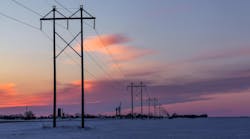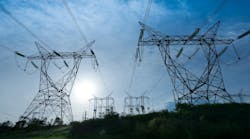THE PEAK DEMAND ON KOREA'S TRANSMISSION SYSTEM IN 2004 WAS 51,264 MW, and the average annual increase in demand is about 8% per annum. The long-term load forecasts indicate that by 2021 there will be a power-delivery deficit of some 16,000 MW in the metropolitan area of Seoul City, Korea.
There are wide regional variations in load density in Korea, a country with a population of some 45 million and an area of 98,500 sq km (39,000 sq mi). More than 45% of the electricity demand is attributable to the metropolitan areas especially around Seoul City. The existing 313-km (195-mile) south to north 345-kV transmission lines are routed through the mountains, which create construction problems in addition to right-of-way difficulties. Therefore, to interconnect the Seoul metropolitan areas with the coal-thermal power plants and nuclear power plants on the coastal regions, The Korea Electric Power Co. (KEPCO) decided to construct an extra-high-voltage (EHV) transmission system operating at 765 kV, with east to west and south to north interconnections.
KEPCO reviewed its future circuit-capacity requirements and decided to develop an environmentally acceptable double-circuit 765-kV transmission line design. With the support of Korean equipment manufacturers, KEPCO was able to commission Korea's first double-circuit 765-kV transmission line in 2003.
765-KV INTERCONNECTION
The first phase of the 765-kV project was the western circuits, the Dangjin line, which interconnect the Dangjin coal-thermal power plant to Sin-Anseong Substation via Sin-Seosan Substation, a transmission line 178 km (111 miles) long. The Sin-Taebaek line eastern circuits interconnect the Sin-Taebaek and Sin-Gapyeong Substations via a 162-km (101-mile) transmission line.
| Item/Year | 2001 | 2002 | 2003 | 2004 |
|---|---|---|---|---|
| Peak load (MW) | 43,125 | 45,773 | 47,385 | 51,264 |
| Energy sales (GWh) | 257,731 | 278,451 | 293,599 | 312,095 |
| Consumption per capita (kWh) | 5444 | 5845 | 6126 | 6491 |
Construction of these two 765-kV lines that are routed mainly through mountainous country was completed in December 1998. Some 689 tubular-steel towers support these transmission lines having an average height of 95 m (312 ft). The ratio of suspension to tension towers is 1.2. These circuits were operated at 345 kV until the 765-kV gas-insulated substations were commissioned in May 2002. Since then, circuit lines have been operating at 765 kV.
The second and third phases of the future 765-kV interconnections include the construction of transmission lines between Sin-Gapyeong Substation to Sin-Gori Nuclear Power Plant in the south via Seo-Geyongbuk and Sin-Anseong Substation, a route length of about 320 km (200 miles). The design of the transmission line from Sin-Gapyeong to Sin-Ansung will be based on the use of single-circuit (waist-type) towers.
DESIGN PARAMETERS CONDUCTOR SELECTION
Conductor selection
The selection of the conductor was just one of the features influenced by the need to minimize the environmental impact on the population living in close proximity to the transmission lines. The Korea Environmental Protection Act (KEPA) determined the designed audible noise (AN) level for the 765-kV line to be 50 dB (A) in foul-weather conditions. This effectively excluded the use of a large four-conductor bundle configuration from consideration. The AN characteristics of possible conductor bundles were examined in a corona cage. The combination of the span length and tower height considerations for the 765-kV line resulted in the selection of the Cardinal 6-conductor bundle.
A full-scale 765-kV test transmission line was erected in 1993 to evaluate the environmental impact of corona in the vicinity of the in-service Cardinal 6-conductor bundles. The average AN level for the 36-month test period measured at 15 m (50 ft) from the outer phase was 48 dB (A) in foul weather and 42 dB (A) in fair weather. The test line also afforded the opportunity to gain operational experience of the electrical and mechanical performance of the hardware and spacer-damper for the line prior to completion of the final specification.
Ground-wire design
The shield angle of ground wire should be less than -8 degrees or 1 m (3 ft) outside the outer-most conductors, and for optical ground wire (OPGW), the allowable temperature and induction problems of communication cable due to induced current were considered. Sag was maintained under the 80% of conductor sag to avoid clashing with the line conductors.
Conductor to ground clearance — standard design
The design ground clearance for transmission lines is determined by considering the safety clearance of electrical equipment, electric and magnetic field strength at ground level, height of trees under the lines and crossing of other structures.
The minimum conductor height was determined to give a maximum electric field below 3.5 kV/m at 1 m above ground in the flat urban areas and 7 kV/m in the mountainous areas. However, to protect the natural environment of the mountainous areas, it is not permitted to remove trees under the lines in Korea. Thus, in practice, the electric field in these areas is less than the design value of 7 kV/m. The minimum conductor height for the 765-kV double-circuit line is 28 m (92 ft).
Insulation design
The height of double-circuit 765-kV transmission line towers and the selected ground-wire shielding angle of -8 degrees provide perfect shielding irrespective of tower height and hillside effects. The designed thunder day level is 20, comparatively less than in most countries, and the outage rate due to lightning is estimated as 0.35 per 100 km (0.22 per 100 miles) per annum assuming 10-Ω to 15-Ω tower footing resistance.
The critical flashover voltage (CFO) of 1580 kV in the switching pulse was assumed considering a maximum switching overvoltage of 1.9 p.u., with an atmospheric correction factor below 1000-m (3300-ft) altitude of 1.08 and a flashover to withstand voltage ratio of 1.176. In the event of a single-phase ground fault in each circuit, the maximum switching overvoltage occurs while the power-frequency overvoltage of the healthy phase in this fault situation is 1.2 p.u.
The minimum air-gap clearance to the supporting tower was evaluated as 4.95 m (16.2 ft), to provide withstand for the maximum 1580-kV CFO from the switching overvoltage analysis. The number of insulator discs in a suspension string is 30, and the mechanical strength is 300 kN (70,000 lb); for a tension string, the comparable figures are 28 discs and 400 kN (90,000 lb).
Spacer-damper and fittings
A new type of spacer-damper was developed for the 765-kV transmission lines using an elastomer as the material to damp vibration amplitude. To improve the performance of the elastomer, it is ball shaped to stabilize the physical characteristics of the spacer-damper from the physical effects of ozone, sun rays, low temperature and other environmental factors. Eight elastomer balls per arm of the spacer-damper give the arm flexibility to damp three-dimensional vibrations. To overcome the problem of looseness in clamping bolts, the locking bolt-and-nut assembly was also developed. For suspension towers, two parallel insulator strings were used. For tension towers, three parallel insulator strings were used. For jumpers, three parallel insulator strings were used.
Tower design
For large-size towers, it is necessary to consider the use of double-member angle steels, but maintenance and repair is more difficult; therefore, steel pipe is used for main and diagonal struts. For crossarms, angle steel is used.
Helicopters were used to transport materials to sites where access was particularly difficult; they were not used to assist tower construction. The steel towers were hot-dipped galvanized during manufacturing, but after erection, the parts above 6 m (200 ft) were painted red and white to comply with aviation law.
SUMMARY
The double-circuit 765-kV transmission lines in Korea operate at the highest transmission voltage in Asia. The development of this design technology began as a research project at the Korea Electric Power Research Institute (KEPRI) in 1984 and continued until the commercial operation was commissioned. KEPRI developed the 765-kV upgrading technology with Korean manufacturers and other research institutes using the full-scale 765-kV test line.
The design concept for 765-kV transmission was focused on environmental aspects such as corona discharge, EMF and wind noise. The analysis and research on the characteristics of double-circuit 765-kV transmission and substation systems ensure that the future 765-kV transmission system benefits from optimal construction and system operational standards. Since commercial operation in 2002, the 765-kV system has operated trouble-free.
Dr. Dong-II Lee received a BSEE degree from the University of Don kook in 1979, a master's degree from the University of In ha in 1983 and a Ph.D from the University of Han yang in 1996. Dong-II Lee held appointments in government and with KEPCO before joining the Korea Electric Power Research Institute of KEPCO in 1985, where he is now group manager of the Transmission Technology Group. His long-term research experience has centered on EHV transmission, environmental and health research issues linked to transmission lines and HVDC transmission. Dong-II Lee is a member of the IEEE/PES, a life member of the KIEE and the Korean delegate on the CIGRE B2 Study (Overhead Transmission) Group. [email protected]
Chang-Hyo Oh received a BSEE degree from the University of Dong-A in 1981 before joining KEPCO. Oh's engineering career centered on transmission lines, starting design and construction before accepting managerial positions. Currently, he is team manager of the KEPCO's Transmission and Substation department, where he has been involved with design and construction of the 765-kV transmission system projects since 1992. He is also a member of the KIEE. [email protected]
765-KV LINE CHARACTERISTICS
The design of the tower sections:
Main and diagonal members — steel pipe
Crossarm and other members — angle steel
Number of circuits and phase arrangement:
Two circuits, three phases per circuit, vertical array
Each phase: 6-conductor bundle (400-mm [16-inch] spacing)
Conductor: Cardinal 54/7 ACSR
Outside diameter 30.4 mm (1.9 inches)
Rated breaking strength 150 kN (33,800 lb)
Aluminum area 483 mm2 (954 MCM)
Ground wire, two sets:
Alumoweld, 200 mm2, OPGW 200 mm2 one set for each.
Lightning factors:
Shield angle: More than -8 degrees or ground-wire arm is 1 m (3 ft) outside of the outermost conductors
20 thunder days per year
Ground resistance : Less than or equal to 15 Ω
Counterpoise wire : Copper-clad steel-stranded cable

